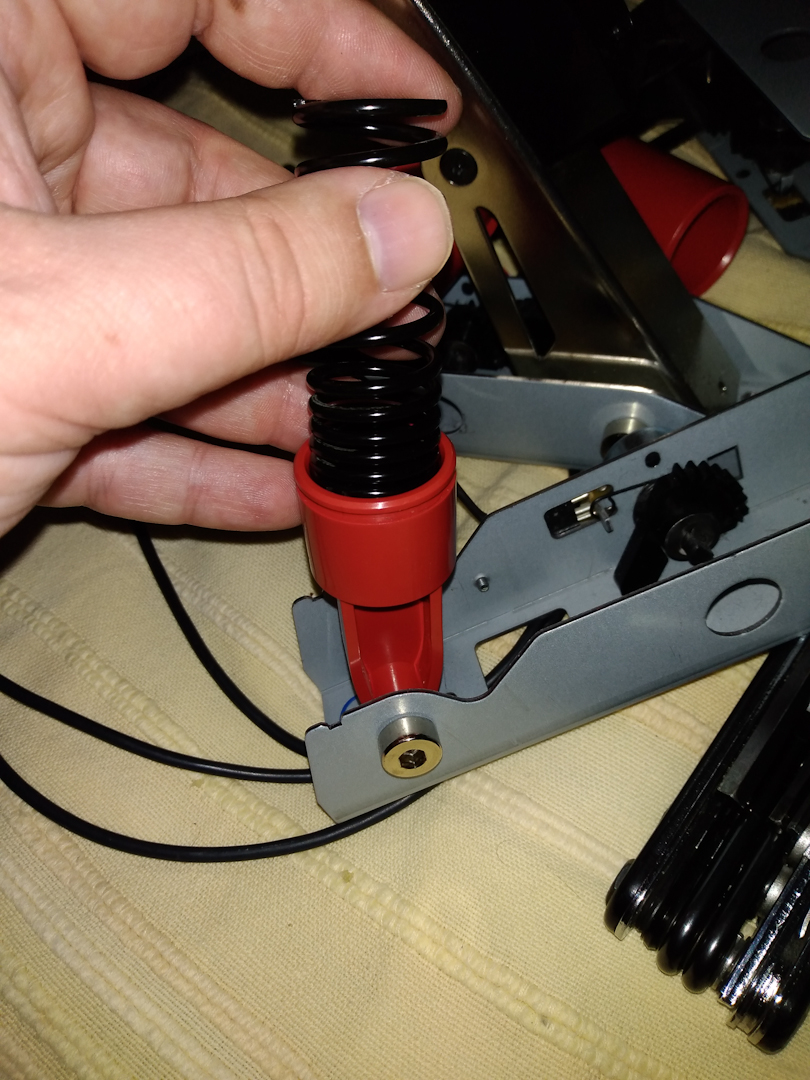
Frugal Mods 1: Springs going Sproing
– or reviewing the GTEYE Springs for the Logitech G-25/27/29/920
Conflict of Interest: None, I bought these pedals with my own money.
I have however sold that wheel set to a friend, after replacing it with a used T500RS, so the last time I used it is about 2 months past, and I‘ m working off my memories and notes from the time here.
Even today the G27 is still a compelling package, containing not only a wheel but also a 3 pedal set, and a shifter. A Package that even beats some of it‘ s successors, which contain a wheel that is despite some changes still mostly the same wheel and lack the shifter, which now has to be bought separately for around 40 Euros or around 60 dollars. This is a hidden increase in price over the old wheels, given that they aimed at roughly the same price point. Additionally, the base package of the Thrustmaster T300, the G-27’s main competitor, and a decided improvement as far as Force Feedback (FFB) is concerned, lacks a 3 pedal set and shifter as well, shipping only with a 2 Pedal set. To get the three pedals, you have to buy the T300RS GT Package which contains the T3PA pedals. Thrustmaster has recognized this need with the more recent T248 Set, which contains the new T3PM Pedals.
Admittedly the G923 has some improvements on the FFB side with, new „Truefeel FFB“, although the usefulness of said FFB improvement is still hotly debated. Some say it does add additional feel and really love it, some find it distracting. In some regards the newer wheels do offer some better functionality, as since the G29/920, all of the function buttons are on the wheel, which makes more controls accessible without taking the hands of the wheel, as well as a rotary encoder on the G29. Though it seems the placement is not ideal as operating the rotary requires taking one hand of the wheel. On the other hand, it does allow for quick adjustments to for example, the brake bias during the lap.
The most important change in the G923 however, is the new driver function which allows you to use the shifter paddles as a dual clutch system.
Another way in which the Logitech G Wheels differ from the G25 and G27, is that from the G29/920 onwards Logitech experimented with various methods of fixing the Wheel set’s worst flaw, the brake pedal.
The G27 and G25 in stock form only have a linear, rather soft, spring for the brake pedal, which gives you next to no feel for how far the pedal is depressed. Which makes it very easy to brake too hard into a corner and giving it “the dash of brake” to shift the balance of the car for better corner entry or proper trail braking next to impossible. This is further not helped by the rather low resolution of 256 steps for the pedals, unlike say the 4096 steps of the Thrustmaster Pedals.
In the G29/920 Logitech placed a rather simple rubber stop there, which increased the resistance of the pedal, but according to most reviewers offered no progressive feel. The G923 however features a progressive spring for the brake pedal.
One that bears a rather uncanny resemblance to the GTEYE springs that will be reviewed here. Which is admittedly, rather easy, given that both are simply black progressive springs.
So, if you are on a budget and already have a G27 or G29 or G920 and want to improve your brake feel to a level comparable to the G923, fear not, you don‘ t have to buy a new wheel set.
All you need is a small spring replacement kit, provided by GTEYE, a small Australian supplier, who started out with the replacement springs, but are now also offering the Leo Bodnar shifter and pedal adapters.
These Adapters allow you to operate the Pedals or the clutch independently from the wheelbase, an option which is particularly well liked in regards to the Pedals as this allows the pedals to use their full resolution of 1024 steps (10-bit) instead of the 256 Steps (8-bit) when connected to the wheelbase. This makes it an attractive option both for users of who have moved on to more high end wheelbases, but also G27/29/920 users who want to use the full potential of their pedals.
Ordering and pricing
The replacement springs are currently available both at GTEYE‘ s Website and their eBay shop, and there are various options to choose from.
These are:
- the brake pedal spring (for the G25/G27/G29/G920)
- the throttle pedal spring (for the G25/G27/G29/G920/G923)
- the clutch pedal spring (for the G25/G27/G29/G920/G923)
- The throttle and Clutch Pedal spring (for the G25/G27/G29/G920/G923)
- The Full set, of brake, clutch and Throttle springs. (for the G25/G27/G29/G920)
The full set, as reviewed here, is currently priced at:
- 49,98 Euros+7,14 Euros Shipping from Australia for the EU. Additional taxes and customs as mentioned below may apply. GTEYE used to have a french distribution centers, but sadly this seems to have has changed, likely due to low stock and high demand during the Corona Pandemic.
https://www.ebay.de/itm/164187883963?hash=item263a5c49bb:g:SeUAAOSw7SZesob~ - 45,22 Pounds+7,14 Pounds of shipping for the UK. (For information on import Tax and custom duties, refer to the section below.)
https://www.ebay.co.uk/itm/161713422412?hash=item25a6df004c:g:yTQAAOSwpDdVYEdx - 49,95$+11,90$ of Shipping for the US from a US Distribution centre, the only one still active at the moment. Therefore there should be no import taxes for US Customers.
https://www.ebay.com/itm/152021653777?hash=item2365325911:g:X8wAAOSwZd1VYD9W - 69,95 AU$+11,90AU$ for Oz……..aka Straya!
https://www.ebay.com.au/itm/163662913352?hash=item261b11df48:g:J9UAAOSwKrhVYDny - 69,95 AUS$+Shipping and customs if ordered from their website:
https://www.gteye.com.au/
Postage/Shipping is usually between 10-30 Dollars, with free postage to Australia, New Zealand and the US. This is due to them changing the shipping to express to account for the logistical challenges of the Current Corona Pandemic, and guarantee delivery in a reasonable timeframe. They do however subisidize the postage fee, so that the customer isn’t the only one holding the bag.
Delivery times from Australia are currently 5-7 days world wide, according to them.
GTEYE offers 3 Years of Warranty against manufacturing errors.
Customs and import VAT
If ordered from their Germany no customs dutie are required, however you will have to pay import VAT of 19% (same as the standard German VAT), which should equate to roughly 10,43€ to 13,26€ in added cost, depending on the upper and lower limits of the postage fee.
You can get a rough calculation here, on the oficial Customs site:
https://www.zoll.de/DE/Privatpersonen/Postsendungen-Internetbestellungen/Abgabenrechner-Zoll-und-Post/abgabenrechner-zoll-und-post_node.html
In the UK no customs duty are required for goods sent from Australia for goods with a worth less than 135 Pounds Sterling. No VAT should be appplied either.
As far as the US is concerned, there should be no issue with taxes due to the US Distribution center.
Disclaimer: This is not legal or financial advice! Should be obvious, but somwhere there is some lawyer trying to twist a rope to hang us with out of this anyway.
Packaging and Delivery
The Springs arrived in a padded envelope, roughly the size of a medium letter envelope, which itself contained the documents and the three clear bags with the springs.
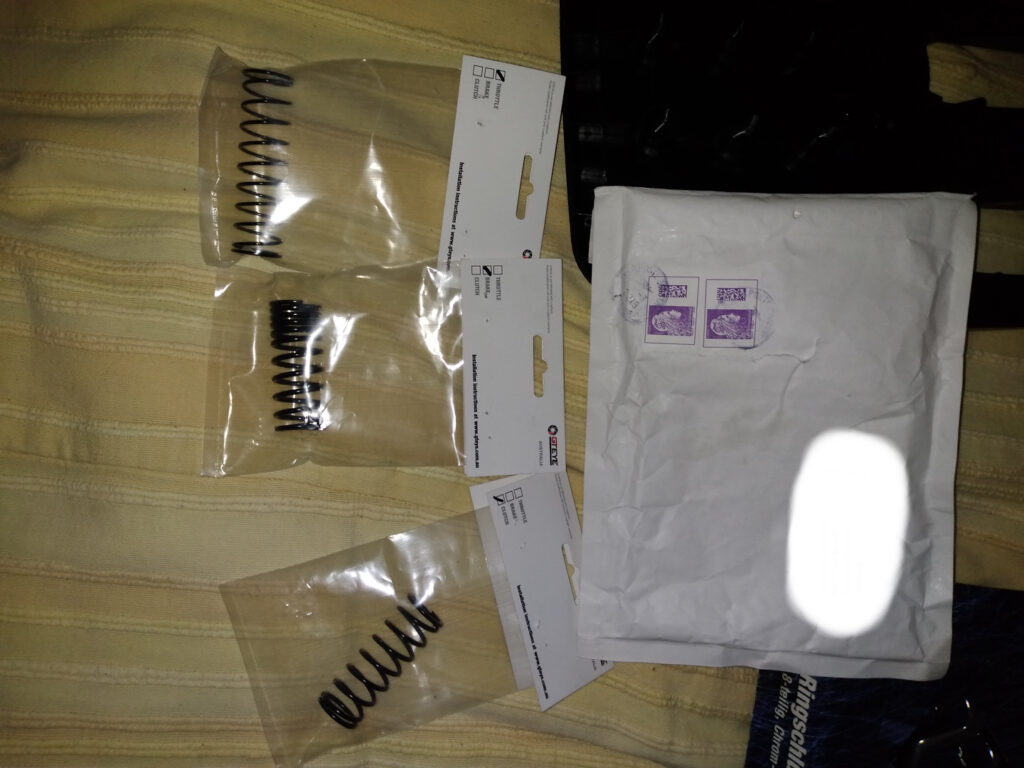
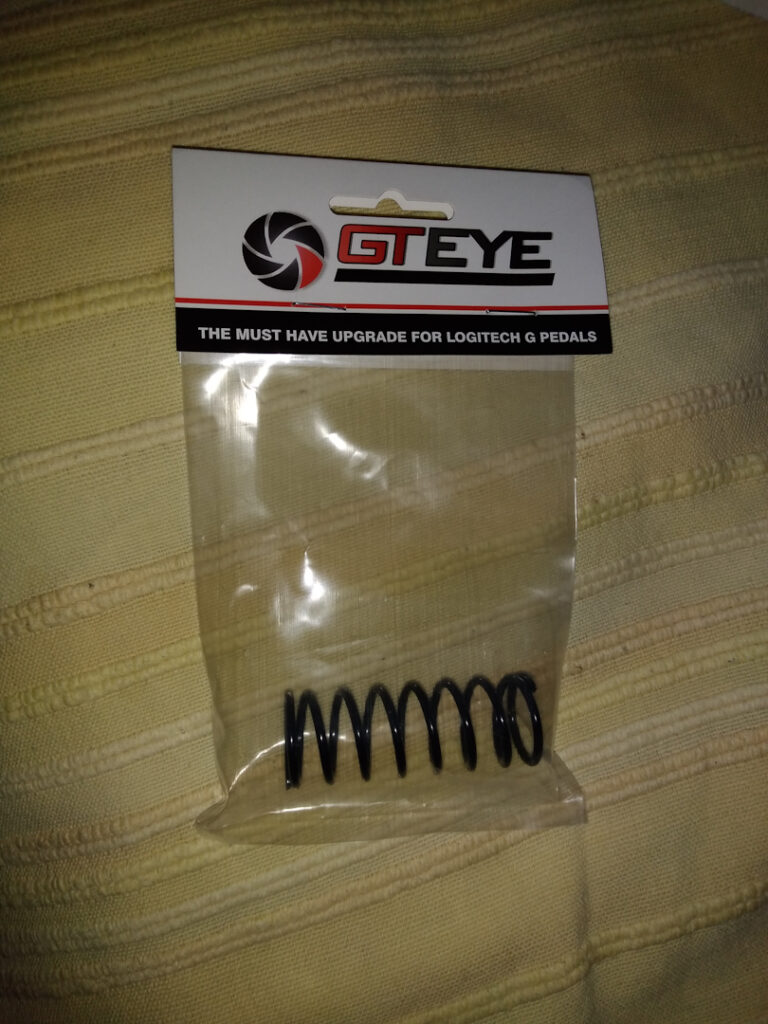
These were labelled for easy identification of the right springs, for brake, clutch and throttle. While that might not have been necessary for the rather distinctive brake spring, it sure is rather helpful when it comes to the throttle and clutch springs.
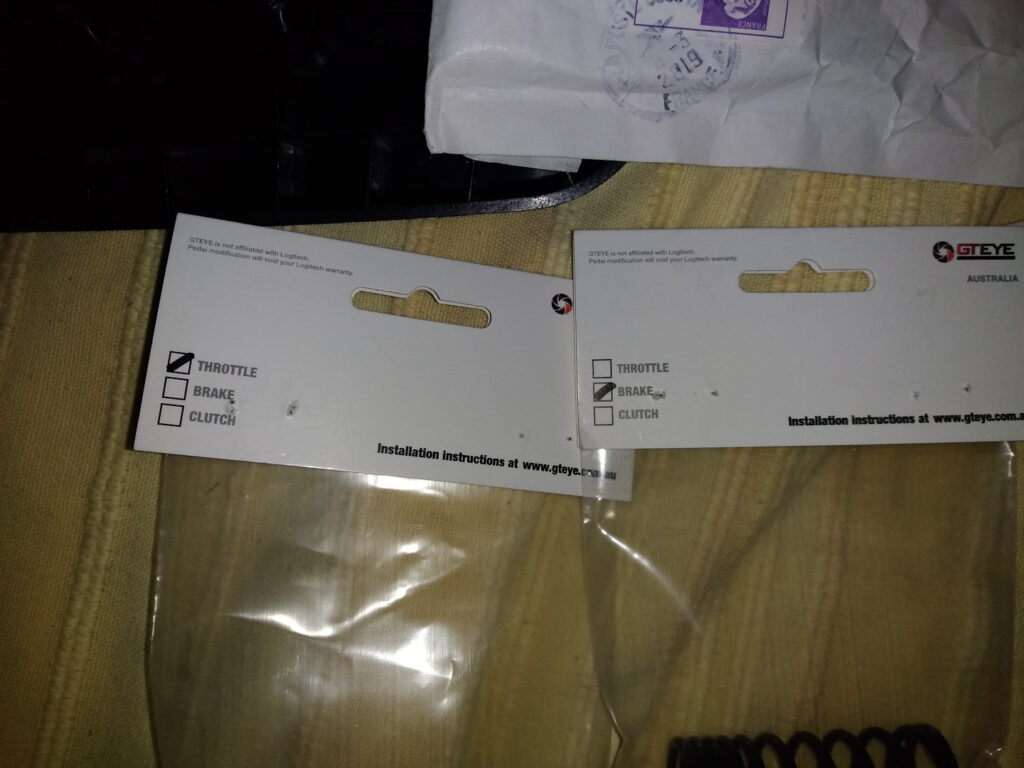
They are noticeably firmer than the original G27 springs, taking much more force to compress.
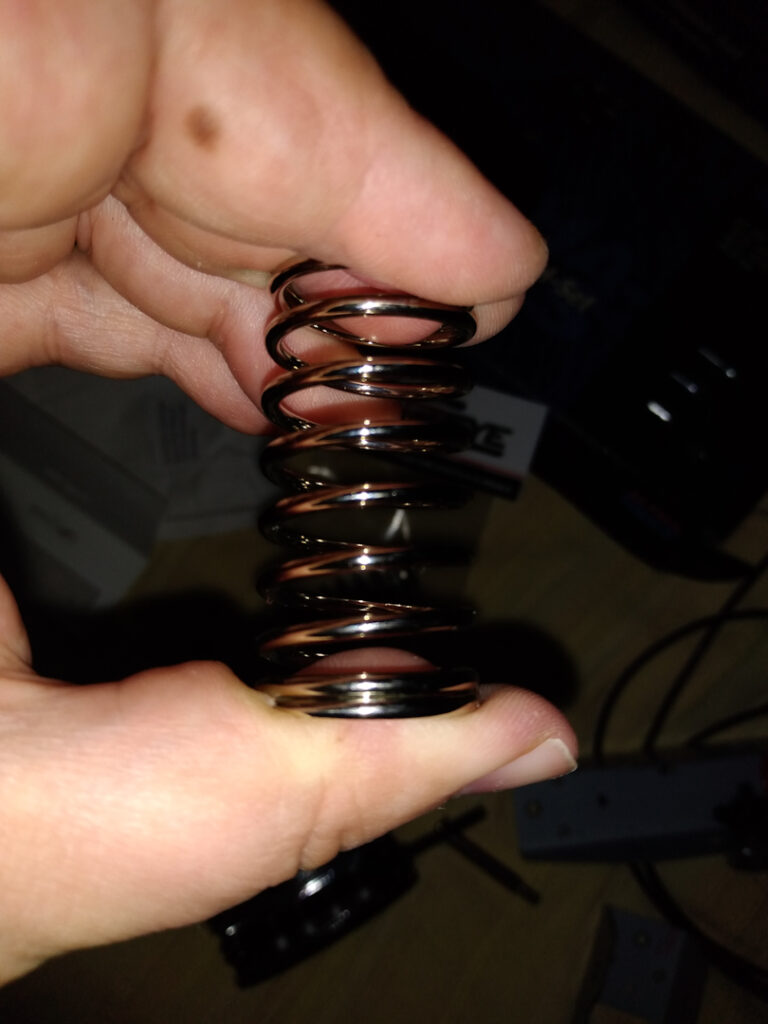
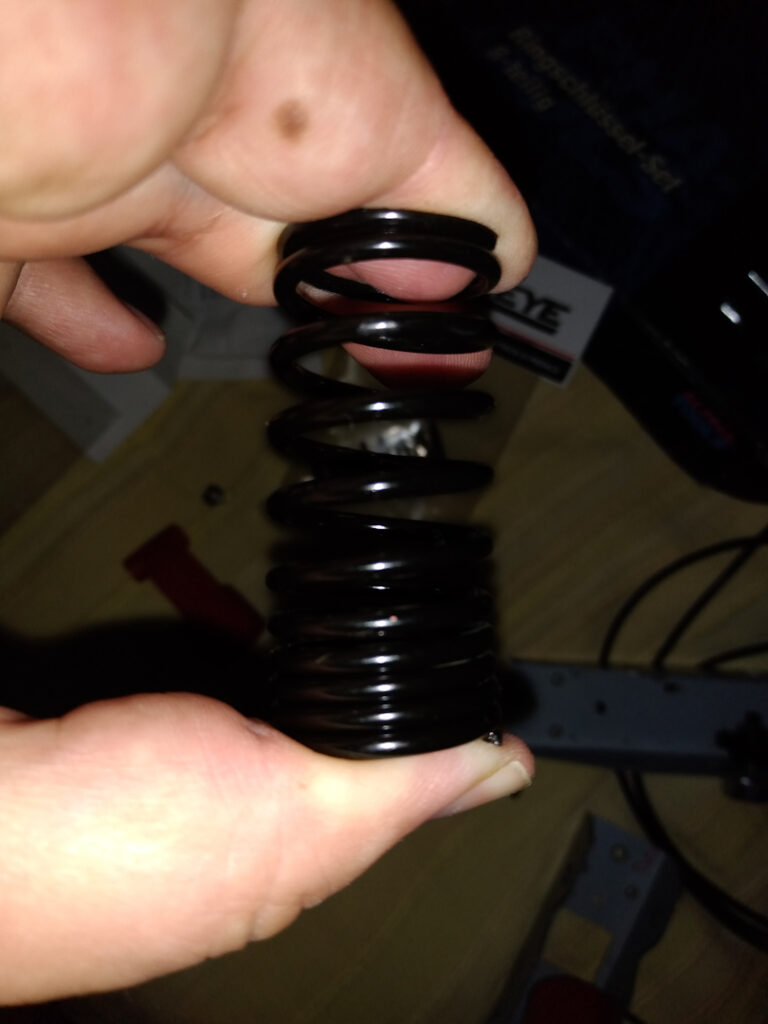
For example, while you can compress some of the original springs between the thumb and fingers, you can’t do that with the GTEYE springs.
However, the old G27 springs were a few years old, so they might’ve been a bit softer than new stock springs.
The GTEYE Springs are finished in in Black gloss coating, called an E-coating to lengthen lifespan, which also makes them look rather nice and distinctive from the Logitech Brakes, which in my case were bare metal.
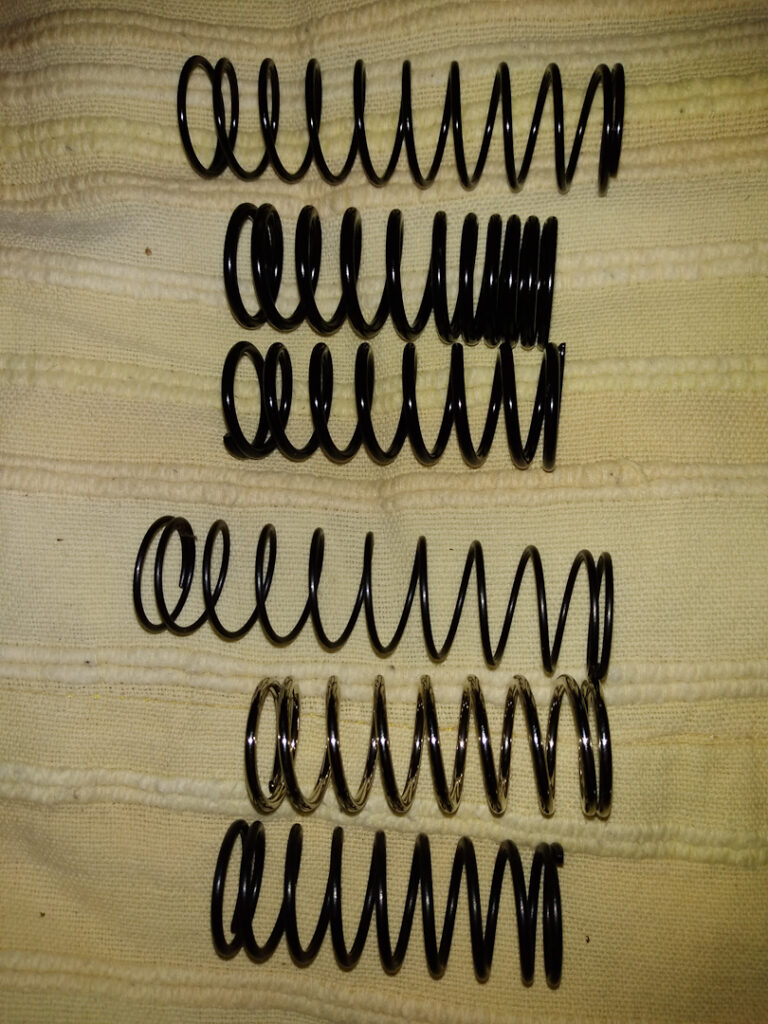
Springs as from above: Gas, Brake, Clutch.
Installation
The Installation is rather simple and takes about 30 minutes, it shouldn’t be any trouble for you if you’ve ever taken apart your G-27 Pedals for cleaning.
GTEYE also provides a handy installation guide:
https://gteyeblog.files.wordpress.com/2015/08/gteye-pedal-spring-instructions.pdf
As this explains the process fully, there’s no need for me to further expand on it.
I only deviated from in in one way, I unmounted the lower half of the Plunger to install the springs instead of the top, which works just as well.
However, you should take into consideration that Logitech may void your warranty if you open up the pedals and modify them. So first make sure that your pedals are in satisfactory working order before any modding is attempted.
The required tools are:
- a cross head/Phillips head Screwdriver or bit set.,
- a set of hex drivers,
- as well as some spanners, I recommend ring head spanners as the tend to slip less than open ended spanners
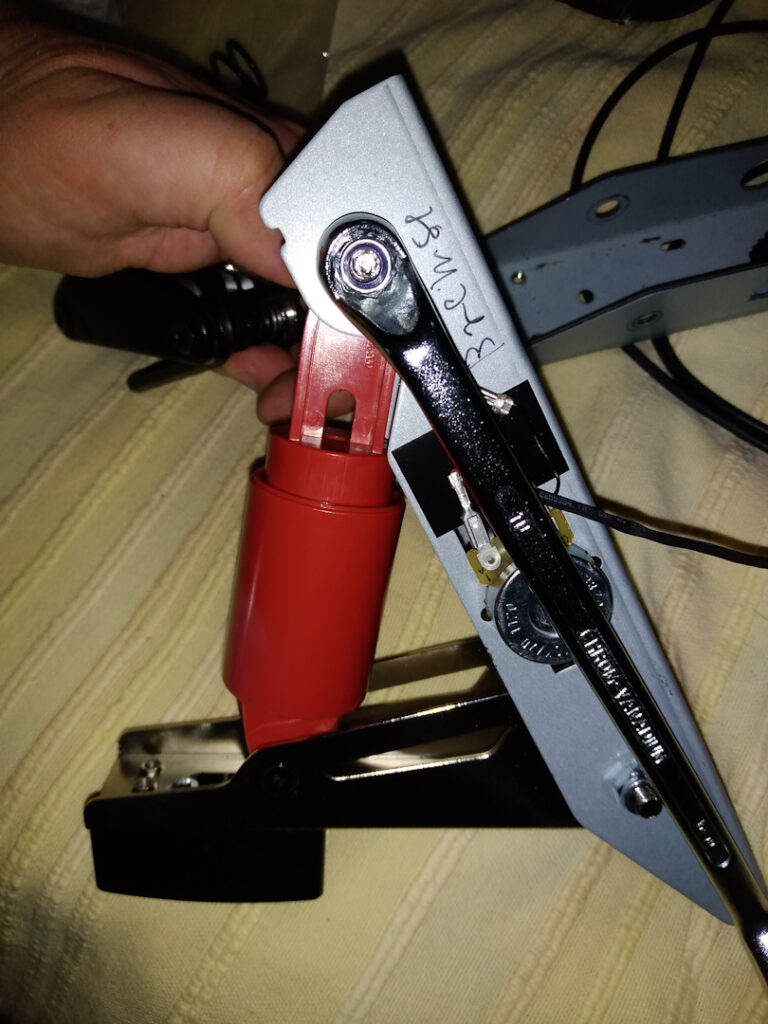
Additionally, you should photograph every step of the disassembly process, so that you have a pictorial step-by-step guide for the re-assembly of the pedals.
Another helpful technique is to stick the screws onto a sheet of paper, using electrician’s tape and mark their type and purpose underneath.
This offers you two benefits:
a) you don’t loose them
and
b) if you do it directly after disassembly, you have another guide for re-assembly. Just retrace your steps in the reverse order.
Make sure to insert the cables into their guide horns and mount the serial cable correctly.
Then close the pedals and fasten the screws securely, but do not overtighten.
Shake the Pedals afterwards to check for loose screws, if something rattles, dissableme and check!
You do not want to have any loose screws in your case, as those can lead to shorts, or get in the pedal mechanism, jamming it.
After finishing those steps, reconnect your Pedals to your wheel and then the PC and test it.
You can re-calibrate the wheel, although it’s not a necessity.
Usage experience
The difference is hard to describe, safe for the old, tired, adage of it being like the difference between night and day, especially the brake pedal.
The Brake Pedal
As mentioned before, my Pedal set was used, so the springs might’ve been a bit worn out and I’ve never owned a G29 or 920.
So I can’t talk about the difference between the G29 or G920 Brake Pedal, but compared to that G27 Pedal, it’s heaven.
There’s a noticeable progressive feel to the pedal, with three zones of stiffness, which gives you information on the pedal travel by feel alone. You instantly know how far the wheel has been depressed, just by the feel, you know if you brake normally hard, or give it just a dash of braking.
Indeed with theses spring I was finally able to give the Car the famous “slight tap” on the brakes for better turn in. (Refer to Empty Box’s “Simracing 101: Brakes are (NOT) for Stopping” https://youtu.be/zXPSj56lavE for further information)
This has utterly transformed simracing for me and made even technical sections like Mount Panorama’s Dipper-Esses Complex much easier and fun for me, as you can just give it a dash of brake to turn it in instead of getting anything between half and full on those corners. This made my my lap times both better overall, as well as much more consistent, as I was able to hit the right amount of braking for each corner with much higher frequency than before on the standard springs. The process was not “brake→check→adjust→check→re-adjust→repeat” as before, but much more intuitive, more like “brake→adjust→corner entry→ease off”, which allowed me to devote more of my “brain computing time” and “brain power” to situational awareness and racecraft.
Which made me both faster, as well as safer to race against.
It also allowed for trail braking into a corner, as you could carefully “bleed off” the brake.
And all that, while still being able to only wear socks while using the pedals, no specialized racing shoes required.
However, I do recommend you put an anti-skid mat underneath the pedals, as unless the anti-skid pads underneath are clean, it is very easy to make them slide, especially if you heel and toe.
The only negative that I can think of, is that while the spring feels significantly stronger than the standard one for the first week, your legs soon become used to that and I would’ve liked a spring that was a bit stronger. However, at the end of a 6 or 12 hour race, you will be happy that this spring isn’t harder…;)
As you can can see the brake spring plays the main role, but both the clutch and the gas springs should not be overlooked.
The Loud Pedal
The spring for the Pedal that makes the sound, also known as gas pedal, is heavier than the original spring, but not by an excessive amount, it’s perfectly balanced to make gas application more precise, but not too heavy for long term usage.
I used it in a 12 Hour Endurance Race in Assetto Corsa, and it was not so heavy that I felt my foot would fall off after an hour. The only time I noticed some discomfort was at the end of my second 2 hour stint that closed out the 12 hours. It does slow down your gas application minimally, but for me that made them more judicious and also eliminated any inadvertent throttle applications, as well as making your throttle application a bit more progressive.
The spring back is near instantaneous and makes it easy to feather the throttle for small gas adjustments, which makes balancing out certain cars easier.
Or help with the constant throttle and gas modulations that certain cars like the Audi Quattro need to be fast.
The Clutch Pedal
While no spring has ever been able to simulate the bite point of a clutch or give you the full clutch feel, even that one is an improvement over the standard spring, as it allows for faster Clutch action given it’s faster spring back to the off position.
It also requires a more decided input to apply, and feels nicer. Generally though, it is the least important of the springs. But really nice if you have old, worn out springs.
Conclusion
The GTEYE is a great, very cost effective way to improve your old set of Logitech Pedals, especially if you have a G27 or G25, which are nowadays in the price range for beginners. Given that they are most likely second or third hand, the springs might be in rather dire need of replacement. Additionally there have been reports of the Brake spring being a marked improvement over the Rubber stop in the G29/G920, so it might be worth a look for owners of those.
The G923 seems to have a spring similar to the GTEYE Springs, so the brake spring will likely fit, but is generally not seen as necessary. You can still buy the Throttle and Clutch springs for it though, if you don’t like the original springs.
If you are strapped for cash and can only afford one piece, get the brake spring, as it has the biggest impact on your performance. If you want a stronger gas spring, you can always switch out the old Brake spring for the throttle Spring, or switch the old brake spring for the clutch and the clutch for the throttle, according to personal preference.
You can then later add the throttle Spring and the throttle spring, in that order, since that is the order of their significance.
You can buy all springs individually to spread the cost out over a few months, but the Bundles do offer some decent savings, given that the full package is a little more than the price of two springs, at 69,95 AU$ or saving of about 19-20 Au$.
The Clutch and Throttle spring set also is only 12,95 Au$ more than one single spring, so even buying the Brake Pedal on it’s own and then the gas and Clutch set nets you about 16 Au$ worth of savings compared to buying each spring individually.
Given it’s low price of about 50-ish Euros to 60-ish Dollars, this is one of the best bang for the buck improvements to make to your G27. Pedals have the biggest impact on your performance, if you have decent FFB, as you can save or loose a lot of time under braking. This has been driven home after my recent switch to the used T500 whose Pedals did not have a brake mod, or rather one that was too used up. I lost about 10 seconds compared to my G27 times, despite the better FFB. Now, after updating the T500RS/T3PA-Pro Pedals with a Brake mod, I’m about 2.5 seconds up on the G27 lap times.
The Thrustmaster T3PA and even the T3PA-Pro offer no improvement relevant to your personal performance over the G27 Pedals modded with these springs. The only advantages both have over the Logitech Pedals is their higher resolution of 12 Bit (4096 steps) over the Logitech’s 8-Bit (256), and the higher build quality and weight of the T3PA-Pro, which are a bit less likely to slide if not hard mounted. Additionally you can switch the T3PA-Pro from F1 style to Roadcar/GT Style.
However all that advantage is lost without a good brake mod, and given the weak springs on the clutch and throttle it is rather easy to over apply both, wasting all that added precision.
The main reason for the Logitech G Pedal’s low resolution are the driver and the wheelbase, not the pedals themselves. If an adapter is used instead of connecting them to the wheelbase, the Logitech Pedals are able to reach 10-bit or 1024 steps, a 4 times increase in resolution. If you combine the Logitech Pedals with this spring set, and an adapter, they can offer higher practical precision than a stock Set of Thrustmaster Pedals. So you don’t necessarily have to buy a new set of Pedals if you want to buy a new wheel, saving you a chunk of money in the process. From what I’ve heard the T-LCM Pedals are an improvement over it, as are the Fanatec CSL and Clubsport V3 Pedals…but given their price range, one should expect that.
And given the forces involved in using them, hardmounting should also be considered.
In short, this is a great bang for the buck mod for those simracing on a Budget. It offers a massive increase in performance over the stock version, and even some higher priced competitors. The 45 Euros I spent on it were probably the best 45 Euros I ever spent on simracing, given how it influenced my driving progression. Well, maybe except a certain shifter that I will review in due time. 
It would be great if there was a version of this mod for the Thrustmaster Pedals, especially the rather weak clutch and gas pedal springs.
